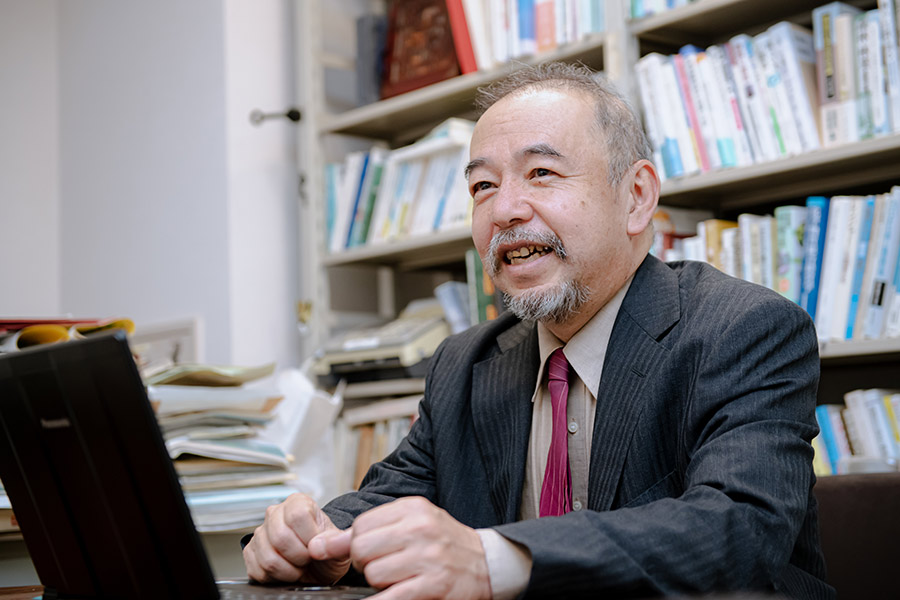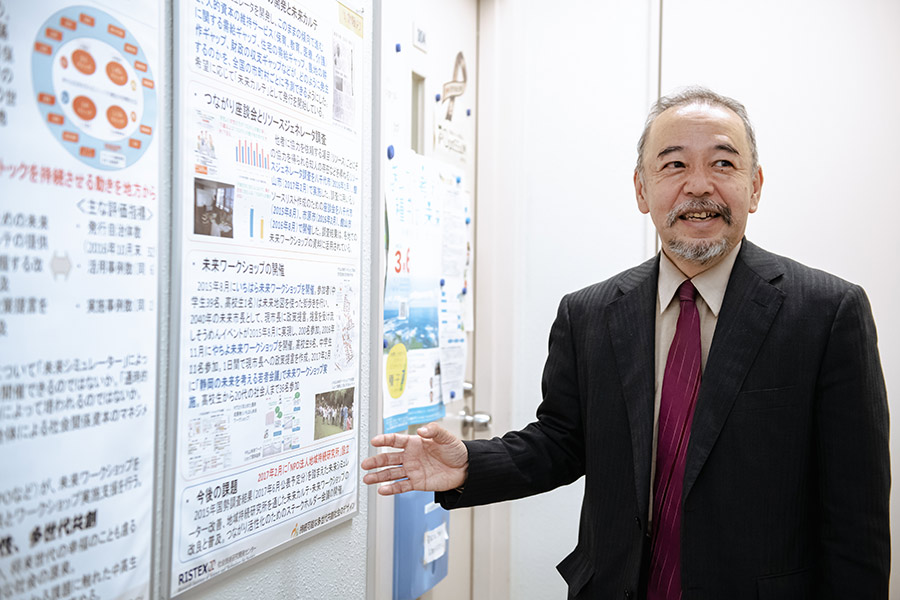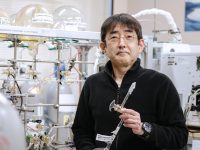In order to safeguard our lives from the threat of global warming, countries worldwide are required to achieve carbon neutrality through decarbonization. Professor Hidefumi Kurasaka of the Graduate School of Social Sciences is conducting research on the necessary policies and actions to accomplish this goal. To begin with, he provides an explanation about “carbon neutrality,” which has gained prominence in recent years.
Carbon Neutrality as a countermeasure against global warming

―Please tell us what Carbon Neutrality is.
At present, human activity is causing an unprecedented increase in greenhouse gases, particularly carbon dioxide, in the atmosphere. This alarming trend is accompanied by a steady rise in global average temperatures, posing significant challenges associated with climate change. In response to this pressing issue, the concept of Carbon Neutrality has emerged as a crucial approach. Carbon neutrality is the concept of achieving a balance between greenhouse gases emitted by human activities, such as carbon dioxide, and their absorption or mitigation. The target is to reduce net greenhouse gas emissions to zero. This means that greenhouse gas emissions must be kept to the extent that plants absorb carbon dioxide through photosynthesis. To achieve this, greenhouse gas emissions need to be significantly reduced through energy conservation and the introduction of renewable energy sources. If natural absorption by photosynthesis alone is not sufficient to reduce carbon dioxide emissions to zero, carbon dioxide must be actively captured by artificial means.
What are the reasons behind the establishment of the global goal to achieve carbon neutrality by 2050?
The European countries, which were the first to recognize the urgency of global warming, raised their voices, and reached an agreement known as the Paris Agreement in 2015. The goal of this agreement was to “limit the temperature rise to within 2 degrees Celsius after the Industrial Revolution and achieve and achieve carbon neutrality by the year 2100.”
Then in 2018, the Intergovernmental Panel on Climate Change (IPCC), a body where scientists provide policymakers with their scientific findings, compiled the “Special Report on Global Warming of 1.5°C.” This report highlighted the need to limit global temperature rise to 1.5 degrees Celsius, as a 2-degree increase would still have limited effectiveness. The report also emphasized that we must achieve carbon neutrality by 2050 to meet the target. As a result, the issue quickly became personal and relatable to us. In 2019, young people around the world, including Ms. Greta Thunberg, who was 15 years old at the time, stood up in 2019. Thus, the keyword “climate crisis” emerged, spreading the idea that we must devote all available resources to address global warming.
―What will be the consequences for the earth if carbon neutrality cannot be achieved by 2050?
Failure to achieve carbon neutrality by 2050 could lead to irreversible adverse effects that cannot be addressed by human measures. For example, the general circulation of the world’s seawater, which generates ocean currents, may weaken. This could be fatal for European countries whose livelihoods depend on the warm currents in the North Atlantic. In addition, melting ice in the tundra would release methane trapped in the soil into the atmosphere, further accelerating global warming.
If global warming continues at the current rate, there is a possibility that the ice in Antarctica will melt, resulting in a significant rise in sea level by several meters. As a result, people living in vulnerable regions, such as riverbanks and areas below sea level, may be forced to migrate. Developing countries that cannot afford to build breakwaters will be particularly affected. These individuals are commonly called “environmental refugees.” We are assuming various adverse effects as a result of global warming.
National Goals to Achieve Carbon Neutrality by 2050

―What specific strategies and initiatives are countries implementing to achieve carbon neutrality?
Most countries worldwide, including developing countries, are signatories of the Paris Agreement. Each country sets its own targets and reports them to the Convention Secretariat. Among them, the European Union (EU) is one of the first to work on carbon neutrality. In 2021, the EU adopted a law that clearly states its commitment to achieving “Carbon Neutrality in 2050.” Additionally, the EU set a challenging mid-term target for 2030, aiming for a 55% reduction in emissions compared to 1990 levels.
The United States tried to withdraw from the Paris Agreement during the Trump administration, but experienced a change in administration to Biden before the withdrawal took place. As a result, the United States remains a participant in the Paris Agreement and has been pursuing policies to achieve carbon neutrality by 2050. China, in 2020, also declared its commitment to achieve carbon neutrality by 2060. In Japan, former Prime Minister Suga declared the goal of carbon neutrality by 2050 during his policy speech in October 2020. In response, the Japanese government will revise its existing target in 2021, aiming to reduce greenhouse gas emissions by 46% by 2030 compared to the level of fiscal year 2013, with a further aspiration of reaching a higher target of a 50% reduction.
However, there are concerns that even if all countries achieve the targets, they have submitted to the secretariat of the Paris Agreement, it may not be possible to limit the temperature rise to below 1.5° C. For this reason, the 2021 Glasgow Climate Agreement mandates that countries shall revise their targets upwards. It is necessary for Japan to further strengthen its goals.
―Please tell us about “Decarbonization Leading Areas” in Japan.
Decarbonization Leading Areas are part of Japan’s decarbonization policies, led by the Ministry of the Environment, to create 100 decarbonization model cases nationwide by 2030. The recruitment process started in January 2022, and as of now, 62 locations have been designated. In Japan, since 2012, the promotion of renewable energy, such as solar power, has been achieved since 2012 by incentivizing power companies to purchase renewable energy at favorable rates. However, in the decarbonization Leading Areas, the focus has shifted towards utilizing renewable energy locally through Independent Transmission Lines* and energy storage systems. Chiba City, where Chiba University locates, was selected as a Decarbonization Leading Area in 2022. I think that was because the plan to connect decarbonized housing with Independent Transmission Lines using a monorail line was highly evaluated.
*Transmission lines installed by entities other than general power transmission and distribution companies. Recently, there have been initiatives led by local governments and similar entities to establish direct connections between local power sources and demand areas. These initiatives aim to promote local production and local consumption of electric power as well as ensure electricity availability during blackouts.
Carbon Neutral Movement at Chiba University

What initiatives is Chiba University undertaking to achieve carbon neutrality by 2050?
First and foremost, it is not the right approach for individuals to endure and strive for carbon neutrality on their own. Instead, it is necessary to ensure that energy conservation and renewable energy investments are prioritized when renovating buildings and durable consumer goods. Additionally, if we can create technologies that utilize carbon dioxide as a raw material to create valuable and profitable, we can significantly advance towards achieving carbon neutrality. One such technology is artificial photosynthesis, which Professor Yasuo Izumi in the Graduate School of Science is working on.
Professor Akira Kato of the Graduate School of Horticulture is working towards creating and expanding a system that enables us to understand the extent to which trees can absorb carbon dioxide. Additionally, starting in October 2022, I have been collaborating with Associate Professor Yuya Fukano of Horticulture on a demonstration project aimed at decarbonizing agricultural regions. This project combines farming-type solar power generation (solar sharing) and smart agricultural technology.
Professor Kazuhito Ichii of the Center for Environmental Remote Sensing is utilizing image information and analysis techniques to determine the composition and proportion of vegetation, aiming to leverage this knowledge for combating global warming. In addition, Professor Yasunari Matsuno of the Graduate School of Engineering serves as an observer in the Keiyo Coastal Industrial Complex Council on Carbon Neutrality, which consists of the Ministry of Economy, Trade and Industry, Chiba Prefecture, and other local governments, companies, and experts. They are considering initiatives to decarbonize the petrochemical complex in Chiba Prefecture and Chiba City.
What role should universities play in achieving carbon neutrality?
One important role is conducting research, collaborating with companies to develop new technologies, and making policy recommendations based on research findings. It is also crucial to recognize that universities, including Chiba University, operate on a scale comparable to a local government, with 15,000 undergraduate and graduate students and several thousand staff members. As such, universities have a social responsibility to actively pursue decarbonization. In September 2020, Chiba University made a declaration to aim for RE100 (covering all electricity consumption with renewable energy) by 2040, and now it has started taking concrete steps toward achieving that goal.


(To be continued in Part 2)
Series
The Role of Universities to Achieve Carbon Neutrality
What role should universities play in realizing carbon neutrality by 2050? This series will explore this question, accompanied by research conducted at Chiba University.
-

#1
2023.06.22
Harnessing CO2 with a Photocatalyst for Fuel and Plastic Feedstocks: Advancing a Sustainable Society with Chemistry
-

#2
2023.06.29
Unlocking Untapped Urban Resources: Driving Carbon Neutrality through Life Cycle Assessment
-

#3
2023.07.04
Predicting Future CO2 Absorption and Emissions in Terrestrial Ecosystems: International Geostationary Meteorological Satellite Network for Accurate Estimation
-

#4
2023.07.12
The Global Goal of Carbon Neutrality by 2050 (Part 1): Universities as Agents of Change
-

#5
2023.07.14
The Global Goal of Carbon Neutrality by 2050 (Part 2): A decarbonized society from a local perspective
-

#6
2023.09.12
Reassessing the role of “Forest Resources” in achieving carbon neutrality: Measuring forests with the combination of drones, mathematics, and computer graphics
-

#7
2023.09.28
Navigating Offshore Wind Power Expansion: Nurturing Ocean-based Wind Energy Management Experts through Industry-Academia Partnership
Recommend
-

CUTICULA: A Secret of Unique Body Shape of Insects −Exploring the Sophisticated Mechanism Behind their Elongated and Round Bodies
2023.12.11
-

Taking up Immunological Research against Incurable Diseases−The Significance of “1” Life
2023.01.12
-

From Virtue to the Stars: Rethinking Education and the Universe through Virtue Ethics
2025.04.18




